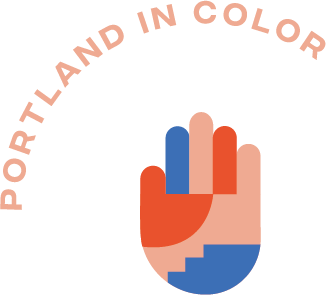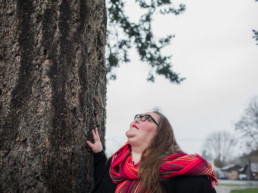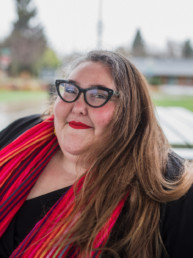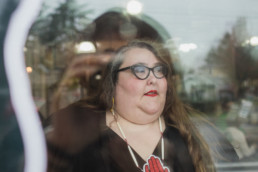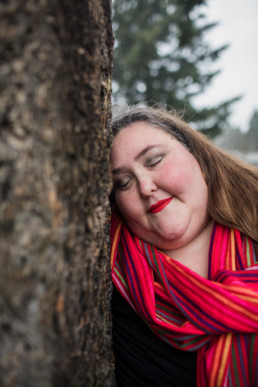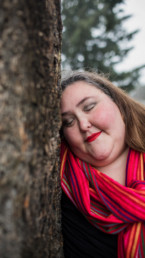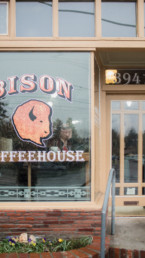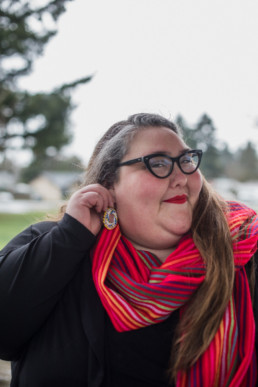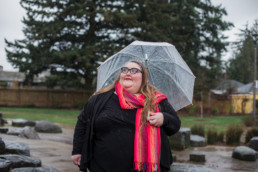SHILO GEORGE
“The more impactful thing is for white people and other communities of color to learn [about] the indigenous lands they’re on.”
Name: Shilo George
Pronouns: she/her/hers
Background: I grew up on this land, just Northwest of Portland. I am Cheyenne, Scottish, and Irish. I grew up mostly with my mom’s family who are white European and didn’t know much about my culture. My biological father, who is Cheyenne, didn’t really know much either. That has to do with historical trauma and colonization.
Medium of choice: Pattern drawing, watercolor painting, photography, and facilitation.
Song of the moment: “Thunder Thighs” by Miss Eaves. “Good as Hell” by Lizzo. “I Wanna Dance with Somebody” by Marian Hill. “Seven Nation Army” by Zella Day.
Shilo George savors the moment before a clean sheet of paper welcomes the splash of watercolors. George spends most days training organizations on how to enact equity beyond colors and boxes, and offers social work services at the Native American Youth and Family Center (NAYA).
Her childhood home in St. Helens, Oregon celebrated art, but Portland is where key aspects of her identity were awakened. Her artwork is conceptually-driven and explores themes of duality and identity. She pumps herself up with riot grrrl punk and hip hop playlists before leading trainings against fat phobia in medical settings, weight stigma, and anti-oppression.
George is a proudly indigenous, queer, super fat femme and the owner behind Łush Kumtux Tumtum Consulting, LLC. She is an artist and activist who performs land acknowledgment ceremonies honoring the tribes and lands on which Portland, Oregon occupies. (Read more on the history—past and present—of local Native American tribes here.) Community is central to her work and life.
What are some projects you’ve worked on that you’re particularly proud of?
[During a class at Portland State University,] I filmed myself weaving. Then, miraculously, a spider came out, weaving its web. I never saw the spider before or after again—it was just that day—and it was perfect. I felt like it was a gift. Then I recorded myself singing a song and going, ‘One two two. One two two,’ for every twist I did. It was really cute.
I also have an art piece that’s going to be in an indigenous art show in February in Seattle.
It’s Cheyenne super fat femme regalia—I take traditional items and make them using contemporary materials.
One [element] is a war club that is a coffee table leg, spray painted silver, then covered in mirror shards. I [added] leather pieces as holders for bright red lipstick. It’s a little bit outer spacey and Sci-Fi, has a funny campiness to it, and the very real energy of being a weapon.
The mirror shards are about experiencing abuse that kind of broke my spirit as a child. I feel like what I’ve been doing throughout my life is picking up the pieces, and so I put those pieces together in making this regalia. I pick myself up and I remake myself into something that’s beautiful and deadly.
I also made a breastplate out of thick, dry blackberry rambles that still had the thorns on them [with] a little bit of beadwork. The next thing I’ll work on is a dress and some moccasins, so I’ll have full regalia. I’m just making it piece by piece.
“I feel like what I’ve been doing throughout my life is picking up the pieces, and so I put those pieces together in making this regalia. I pick myself up and I remake myself into something that’s beautiful and deadly.”
What was it like studying art in a higher ed institution, especially as an indigenous student?
I started at PCC, then transferred over to PNCA. I was only able to be there for a year because I couldn’t get a scholarship, but it totally changed how I saw the art world and my own process. It really expanded my horizon of what you could do and what I could do.
There were only two other indigenous artists there, but we found each other quickly. Demian DinéYazhi’ and I met regularly. It was really hard to get good critique because [non-Native peers and staff] didn’t understand the history of this country, colonization, or its impact on Native people, so we would give each other critique and support.
I had to go to PSU to finish my last two years and I was so mad. But what PSU had that PNCA didn’t was an Indigenous Nations Studies department and Wendy Red Star. Any class she was teaching, I would take. That was really helpful in developing my vision as an artist; somebody who could critique my work, give me feedback, and somebody who I could look up to.
How does art shape your work at NAYA and as an independent anti-oppression consultant?
At NAYA, it’s a process of helping people have vision about their lives and introspection. It’s about being creative in their lives and problem-solving. Doing consulting, I’ve found, is all about thinking outside the box and being able to conceptually understand complex systems, and relationship dynamics between people, so that you can offer support and ideas.
That’s one of the things that makes me unique—being able to pull artistic vision and process, with indigeneity, a social work background, and being a person healing from trauma wanting to help the community heal in that way. Going through the critique of art school also helps you be a little bit less precious about whatever you’re making which allows for collaboration and room for critique, criticism, and criticism for yourself.
When did Portland become home and how does the city inform your work?
I’m 43 and, for over three decades, I’ve been coming into Portland with my family. I moved to Portland when I was 19 or 20 years old. I came out and it was really wonderful. I identified as a dyke (queer wasn’t a word that had been reclaimed yet.) There was a women-only space [that] was so beautiful and totally wild for me. It was also really sweet. I did a lot of healing there and learned about myself and my spirituality.
I then connected with my grandfather’s sister who lived in town at the time. She was enrolled in our tribe [and] told me a lot about her mom—my great grandmother—[who] had a really hard life and things really crumbled when she had to go to Indian boarding school when she was five.
I started going to a Native club. It was hard to get access to Native community as someone who didn’t grow up in it, because when you don’t grow up with it, you often have the same colonial ideas. Then you show up in Native spaces and you have those ideas, maybe use those words or romanticisms, and Native people are like, ‘Get out,’ especially if you’re light-skinned like me, which is completely understandable. But being able to access it through college and other Native students was amazing.
Over the last 13 years, I’ve been able to become more culturally aware and part of Portland’s Native community. It’s been really healing and has driven what I’m doing now in life. My ancestors brought me to that—they wanted my healing.So for me, Portland has been a really beautiful place [for] that. Unfortunately, Portland has lost some its small town feel, but the influx of more communities of color is really important. When I see others who come into the community who maybe didn’t grow up with their culture, I try to be open and welcoming to them because it can feel really difficult.
You begin many workshops and events with a land acknowledgment ceremony. Can you talk about what that looks like and why it’s important?
Land acknowledgment is an important indigenous protocol. When you come to someone’s land, [you] ask for permission to be there, usually bring gifts, and thank them. When you’re on their land, you treat that place with respect and leave it better than you found it.
I’m Cheyenne, Scottish, and Irish, so I’m a guest here. This isn’t my land. Part of the work that I want to do to honor the ancestors and tribal people that are still here [by] acknowledging that I’m a guest here, whose land we’re on, and teach other people to do the same.
It’s really impactful when non-Native people—especially white people—give a land acknowledgment. We’re often asked to give land acknowledgments, but the more impactful thing is for white people and other communities of color to learn how to do that and really learn about the indigenous lands they’re on. It’s part of awareness. There’s a lot of invisibility of indigenous people as a part of colonization and genocide, so this works against that.
What’s next?
Well, the art show in February, and then a lot of the creativity I’m doing is creating curriculum and transformative learning experiences. I’m hopeful that other people will want to pick up the work that I’m doing—looking at trauma-informed care as a piece of equity work, along with cultural humility, to battle out bias, discrimination, bigotry, and oppression.
I’m currently a TEDx alternate. I’m also writing a book with three other people that will be published in probably late 2020 called Body Sovereignty, Fat Politics, and the Fight for Human Rights.
[The book] is going to be a much more intersectional look into fat phobia, fat activism, and fat oppression. We have our [academic] publisher, so now we have to just keep on writing it! It’ll be a book that’s used in college classes, but we also want it to be accessible to read for community members as well.
